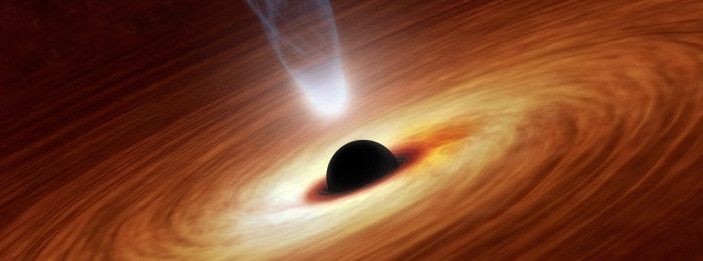[from Engadget]
Black holes are, by definition, impossible to see by conventional methods and are often further obscured by thick blankets of dust or gas. But that’s not an issue for NASA’s Nuclear Spectroscopic Telescope Array (NuSTAR). It can peek through the obscuring layers and monitor the black holes via the high-energy X-rays that they emit. And, after a recent survey that spotted five previously unknown supermassive black holes in the centers of various galaxies, NASA researchers now think there could be millions of of them dotting the Universe like the holes of an intergalactic colander.
“Thanks to NuSTAR, for the first time, we have been able to clearly identify these hidden monsters that are predicted to be there, but have previously been elusive because of their surrounding cocoons of material,” said George Lansbury of Durham University in a statement. “Although we have only detected five of these hidden supermassive black holes, when we extrapolate our results across the whole universe, then the predicted numbers are huge and in agreement with what we would expect to see.” The team’s research has been accepted for publication in The Astrophysical Journal.

Did the general relativity road of twentieth century physics and cosmology become a new religion masquerading as science? How much have we really changed when it comes to science establishments? Think back to the arrest of Galileo or back to Ptolemy and the epicycles. Everything from the accelerating universe to dark energy is theorized using a gravitational model of cosmology based on the general theory of relativity, which turned out to be based on self-contradicting non-Euclidean geometry. Here is a link to an explanation about the self-contradicting non-Euclidean geometry and why because of it general relativity lost its coordinate system. Part II of the article explains why this flaw was overlooked throughout the twentieth century. You can understand it even if your math education didn’t exceed high school geometry:
https://www.facebook.com/notes/reid-barnes/when-is-an-assertion-about-coordinates-merely-an-assertionan-unsupported-asserti/789731027746140
Wow! That’s one incredible argument that you have posted to Facebook. I would more easily understand it, if it were prefaced with your main point. But let me try to summarize. I think that you are saying this…
Einstein’s general theory of relativity appears to dismiss a rigid and universal frame of reference (what you alternatively call a “coordinate system” and/or non-Euclidean geometry). You feel that this dismissal may undermine much of what we observe and know to be true.
I can respond to the assertion, as paraphrased. A physicist would very likely provide a more authoritative and clear response…
Einstein’s special theory of relativity has shattered our concept of a single universal frame of reference, but it has not nullified or undermined the established protocol for measuring 3 dimensional space. Distances and angles exist pretty much as we imagine, but of course on the grand scale of light years.
What Einstein demonstrated (and what has also been validated conclusively in the decades that followed) is that the speed of light is constant from any viewer frame of reference — even if the viewer is moving.
This fact, forced him to reconcile the paradoxes that arise from such a non-intuitive discovery (It is non-intuitive, because it doesn’t have impact in our low-speed existence).
As a result, Einstein theorized (and again, it is now accepted fact), that time and space are malleable. Certain constraints prevent us from visiting the past or affecting the future, but some very shocking things are provable. For example, an individual who travels at great speed and then returns experiences a shorter period of time than his earthbound friend. (At speeds & duration traveled by rockets, the time difference is small, but matches theory precisely).
Gravity curves the space around it, but this, too, does not invalidate Euclidean measurement. I like to think of the “curve” as a way to calculate the position of objects whose received light waves have been bent by the effect of massive objects near its path. (I especially like the metaphor of massive objects having weight on a 2D sheet of rubber and creating a parabolic gravity-well). Ultimately, gravity, space and time are interrelated in ways that we did not appreciate before Einstein.
Of course, there are some really incredible paradoxes. One of these is the EPR paradox which I wrote about here at Lifeboat: http://lifeboat.com/blog/2015/06/quantum-entanglement-epr-paradox
These, too, resolve in a manner that is consistent with observation, but with some profound implications that inspire awe. They are the quantum phenomena that are sometimes used to support or refute the existence of God or of multiple universes.
In my opinion, they are simply the way in which the universe works. Not all of it is obvious to our senses, because our senses weren’t designed to discern things beyond our frame of reference and our immediate environment.
Did I get the gist of your Facebook complaint? If not, please summarize. Explain it as if you were talking to a child, and I promise to give you my best “adult” response. Cosmology and quantum physics are clearly not my fields, but I enjoy clarifying the fraction of phenomena around which I can wrap my brain.
Philip Raymond
CRYPSA.com Co-chair
Cryptocurrency Standards Association
First of all should know the structure of the universe that can be understood by a lot of phenomena and the true cause of the phenomena in the universe.
The universe is an infinite sphere, without expansion, completed basic substance ether, from which matter is formed by the same high vibrations, which form the strings whose sections of materialized in the form of quarks which make up the yen entity by the forces of assembly-gluons and thus acquire atomic particles (protons, neutrons, etc.).
Accompanying features the creation of matter and gravity, which is tasked with the matter back to the original state are ether, and this takes place through black holes. It is certain that a greater amount of stars or galaxies are black holes.